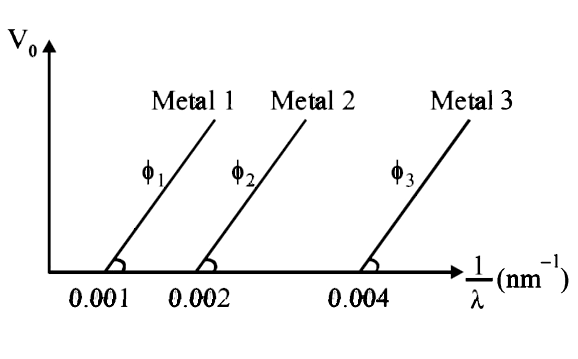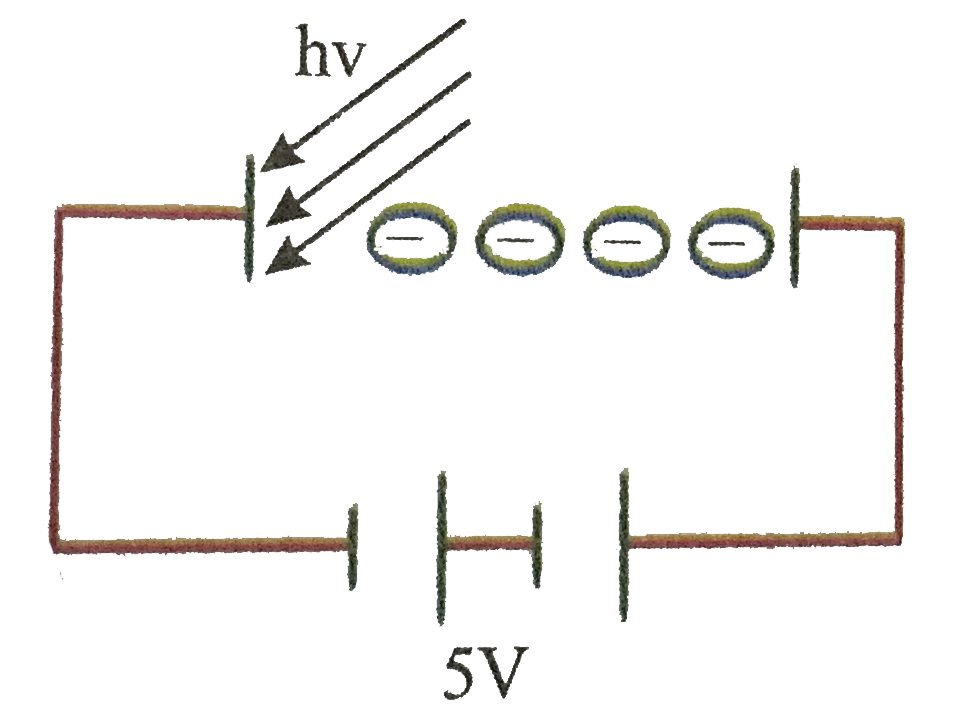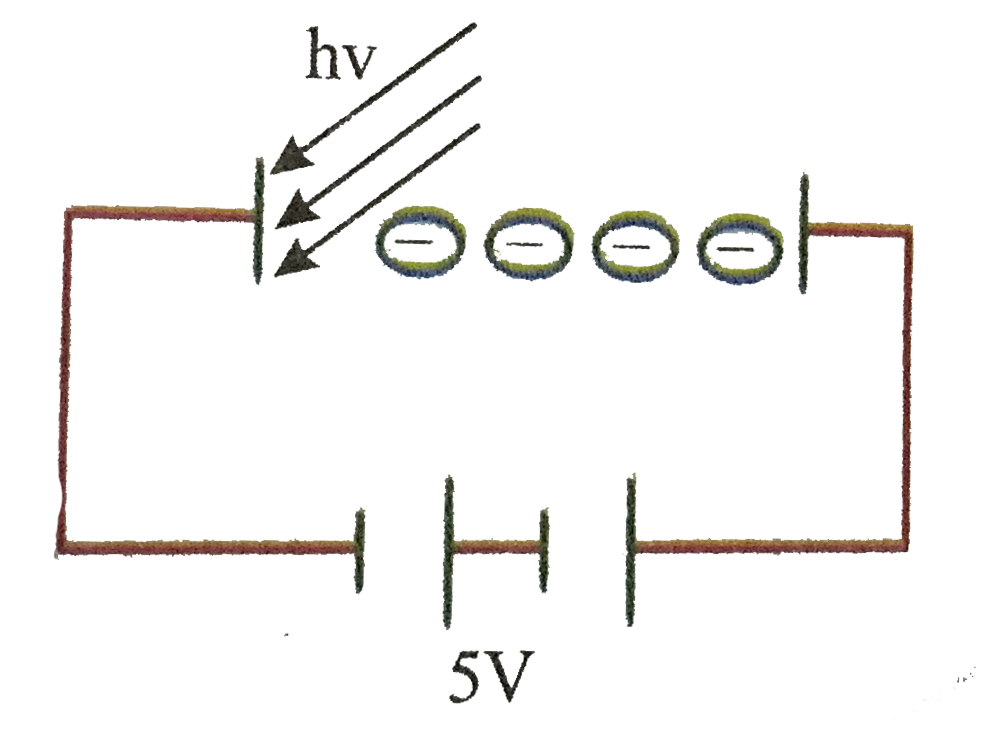Complete Solutions to LEVEL-V of chapter DUAL NATURE of Class 12 book with complete answers and questions
| Class 12 | PHYSICS |
| Chapter | DUAL NATURE |
| NARAYANA | LEVEL-V |
| Number Of Questions | 31 |
| Academic Year | 2023-24 |
When stopping potential is applied in an experiment on photoelectric effect, no photo current is observed. This means that
View SolutionTwo separate monochromatic light beams `A` and `B` of the same intensity (energy per unit area per unit time) are falling normally on a unit area of a metallic surface. Their wavelength are `lambda_(A)` and `lambda_(B)` respectively. Assuming that all the the incident light is used in ejecting the photoelectrons, the ratio of the number of photoelectrons from beam `A` to that from `B` is
View SolutionWhen a centimeter thick surface is illuminated with light of wavelength `lamda`, the stopping potential is V. When the same surface is illuminated by light of wavelength `2lamda`, the stopping potential is `(V)/(3)`. Threshold wavelength for the metallic surface is
View SolutionWhen monochromatic radiation of intensity I falls on a metal surface, the number of photoelectrons and their maximum kinetic are N and T respectively. If the intensity of radiation is 2 I, the number of emitted electrons and their maximum kinetic energy are respectively.
View SolutionThe frequency and intensity of a light source are both doubled. Consider the following statements
A. The saturation photocurrent remains almost the same
B. The maximum kinetic energy of the photoelectrons is double
View SolutionThe work function for sodium surface is 2.0eV and that for aluminium surface is 4.2eV. The two metals are illuminated with appropriate radiations so as to cause protoemission. Then
View SolutionA point source of light is used in a photoelectric effect. If the source is removed farther from the emitted metal, the stopping potential
View SolutionA point source causes photoelectric effect from a small metal plate. Which of the following curves may represent the saturation photocurrent as a function of the distance between the source and the metal?
View SolutionWe may state that the energy E of a photon of frequency `nu` is `E =hnu`, where h is a plank's constant. The momentum p of a photon is `p=h//lambda` where `lambda` is the wavelength of the photon. From the above statement one may conclude that the wave velocity of light is equal to
View SolutionA particle of mass `M` at rest dacays into two particle of masses `m_(1)` and `m_(2) `having non zero velocity . The ratio of the de Broglie wavelength . The ratio of the de Broglie wavelength of the particle `lambda , _(1) // lambda_(2)` is
View SolutionLet p and E denote the linear momentum and energy of a photon. If the wavelength is decreased,
View SolutionThe wavelength `lambda` of de Broglie waves associated with an electron (mass `m`, charge) accelerated through a potential difference of `V` is given by (`h` is planck's constant):
View SolutionTwo particles of masses `m` and `2m` have equal kinetic energies. Their de Broglie wavelengths area in the ratio of:
View SolutionThe wavelength of de-Broglie wave associated with a thermal neutron of mass `m` at absolute temperature `T` is given by (here, `k` is the Boltzmann constant)
View SolutionA proton and an electron are accelerated by the same potential difference, let `lambda_(e)` and `lambda_(p)` denote the de-Broglie wavelengths of the electron and the proton respectively
View SolutionPhotoelectric effect supports quantum nature of light because
(a) there is a minimum frequency of light below which no photo electrons are emitted
(b) the maximum kinetic energy of photo electrons depends only on the frequency of light and not on its intensity
(c ) even when the metal surface is faintly illuminated, the photo electrons leave the surface immediately
(d) electric charge of the photo electrons is quantised
View SolutionWhen photons of energy `4.25 eV` strike the surface of metal A, the ejected photoelectrons have maximum kinetic energy `T_(A)` eV and De-broglie wavelength `lambda_(A)`. The maximum energy of photoelectron liberated from another metal B by photon of energy 4.70 eV is `T_(B) = (T_(A) - 1.50) eV` if the de Brogle wavelength of these photoelectrons is `lambda_(B) = 2 lambda_(A) `, then
View SolutionThe graph between the stopping potential `(V_(0)) and ((1)/(lambda)) ` is shown in the figure `phi_(1) , phi_(2) and phi_(3)` are work function , which of the following is /are correct

View SolutionWhen a monochromatic point source of light is at a distance of `0.2` m from a photoelectric cell, the cut off voltage and the saturation current are respectively `0.6V` and `18.0 mA` if the same source is placed `0.6 m` away from the photoelectric cell , then
View SolutionThe collecter of the photocell (in photoelectric experiment ) is made of tugsten while the emitter is Platinum having work function of `10 eV`.Monochromotic radiation of wavelength `124 Å` & power `100 ` watt is incident on emitter which emits photo electrons with a quantum efficiency of `1%`.The accelerating voltage acros the photocell is of `10,000` volts (Use: `hc=12400eV Å`)
What is the power supplied by the accelerating voltage source.

View SolutionThe collecter of the photocell (in photoelectric experiment ) is made of tugsten while the emitter is Platinum having work function of `10 eV`.Monochromotic radiation of wavelength `124 Å` & power `100 ` watt is incident on emitter which emits photo electrons with a quantum efficiency of `1%`.The accelerating voltage acros the photocell is of `10,000` volts (Use: `hc=12400eV Å`)
The minimum wavelength of radiation coming from the tungsten target (collector) is

View SolutionThe collecter of the photocell (in photoelectric experiment ) is made of tugsten while the emitter is Platinum having work function of `10 eV`.Monochromotic radiation of wavelength `124 Å` & power `100 ` watt is incident on emitter which emits photo electrons with a quantum efficiency of `1%`.The accelerating voltage acros the photocell is of `10,000` volts (Use: `hc=12400eV Å`)
If the source of monochromatic radiation of wavelength `124 Å` has an efficiency of `50%`, and the power of `X` ray emitted by the tungsten target is `3W`, the overall efficiency of the apparatus for `X-ray` production is

View SolutionIn a photoelectric effect set up, a point source of light of power `3.2 xx10^(-3) W` emits monoenergetic photons of energy `5eV`.The source is located at a distance of a stationary metallic sphere of work function `3eV` and radius `8xx10^(-3)m`.The efficiency of photoelectron emission is one for every `10^(6)` incident photons.Assume that the sphere is isolated and initially neutral and the photoelectrons are initially swept away after emission.
Find the number of photons emitted per second
View SolutionIn a photoelectric effect set up, a point source of light of power `3.2 xx10^(-3) W` emits monoenergetic photons of energy `5eV`.The source is located at a distance of a stationary metallic sphere of work function `3eV` and radius `8xx10^(-3)m`.The efficiency of photoelectron emission is one for every `10^(6)` incident photons.Assume that the sphere is isolated and initially neutral and the photoelectrons are initially swept away after emission.
Find the maximum kinetic energy of photoelectrons:
View SolutionThe radius of and `alpha`-particle moving in a circle in a constant magnetic field is half of the radius of and electron moving in circular path in the same field. The de Broglie wavelength of `alpha`-particle is n times that of the electron. Find n (an integer).
View SolutionThe de Broglie wavelength of an electron moving with a velocity of `1.5xx10^(8)ms^(-1)` is equal to that of a photon find the ratio of the kinetic energy of the photon to that of the electron.
View Solution`'S'` is isotropic point source producing monochromatic radiation with power `P`. Force on hemisphere is `P/(nC)`. Find the value of '`n'` (C is speed of ligth).
View SolutionA monochromatic source of light operation at 200 W emits `4xx10^(20)` photons per second. Find the wavelength of the light `"(in" 10^(-7)m`).
View SolutionAn electron of mass `m` with an initial velocity
`vec(v) = v_(0) hat`(i) `(v_(0) gt 0)` enters an electric field
`vec(E ) =- E_(0) hat (i)` `(E_(0) = constant gt 0)` at `t = 0` . If `lambda_(0)` is its de - Broglie wavelength initially, then its de - Broglie wavelength at time `t` is
View SolutionAn electron (mass m) with an initial velocity `vecv=v_(0)hati` is in an electric field `vecE=E_(0)hatj`. If `lambda_(0)=h//mv_(0)`. It's de-broglie wavelength at time t is given by
View SolutionLight of wavelength 180 nm ejects photoelectrons from a plate of metal whose work - function is 2 eV. If a uniform magnetic field of `5xx10^(-5)` T be applied parallel to the plate, what would be the radius of the path followed by electrons ejected normally from the plate with maximum energy.
View Solution
LEVEL-V questions and complete solutions for chapter DUAL NATURE of NARAYANA PHYSICS (HINGLISH) of Class 12